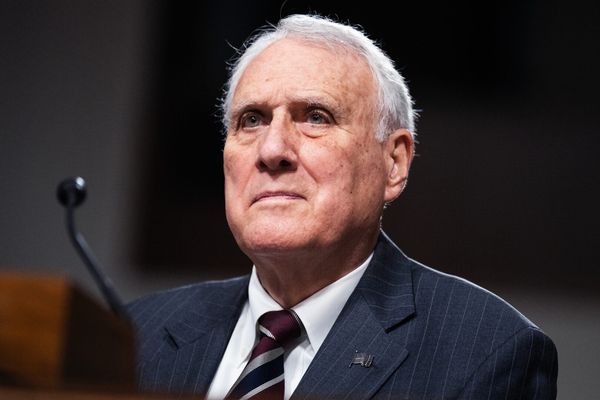Enervate sells products made out of paper. So that might be office supplies; that might be janitorial paper, which is toilet tissue, toilet seat protectors; and local newspapers. And that is in order of quality.” Ken Davies, played by British comedian-of-the-moment Tim Key, says this with a self-satisfied smirk in the opening episode of The Paper – a new sitcom from the team behind the US version of The Office that exists in the same universe as fictional paper company Dunder Mifflin.
The show’s credits feature newspapers being used for all manner of purposes: wrapped around food or rubbish, stacked to form a platform for seeing over a fence, folded to make an impromptu sunhat. Anything, really, aside from being actually read. It’s a neat encapsulation of that old adage about today’s news becoming tomorrow’s chip paper – and a potent visual of how journalism is viewed by many in 2025.
Of course, when you are a journalist in 2025, it makes for bittersweet (read: heartbreaking) viewing. Sure, I’m relieved that it’s a genuinely funny follow-up to such a beloved and long-running comedy series, a full 20 years after the latter first aired. But it’s also incredibly – painfully, even – on the nose. Focusing the mockumentary format around the plight of regional Ohio newspaper the Toledo Truth Teller (TTT), the writers have shrewdly observed the bleak realities of an industry that is not just in decline but, in many cases, on its knees.
This backdrop is swiftly and starkly presented in the pilot episode; a black and white “documentary” about the TTT in 1971 shows a bustling newsroom staffed by nearly a thousand people, including 100 reporters covering Ohio politics and 300 more covering Washington and New York and foreign bureaus all over the world.
“Is it expensive? You can bet what you’re sitting on it is,” says former publisher John Stack. “We only keep democracy alive is all. Is it worth it? Ask the Cincinnati city council” – he stabs his finger at a fresh news sheet – “a third of them, indicted on bribery charges today, thanks to our reporting.”
The action cuts straight to the modern TTT, where “compositor” Mare Pritti (Chelsea Frei) shows the camera how she creates the daily paper by dragging pre-written stories (though only those “in our subscription tier”) straight from AP (Associated Press) wires into the newspaper layout. Her front-page pick? “Elizabeth Olsen Reveals Her Nighttime Skin Routine.”
Elsewhere, unhinged Italian editor Esmeralda Grand (White Lotus’s Sabrina Impacciatore) explains seriously that the publication’s website is where they can focus on “classic, long-form journalism” – before unveiling her proudest work, an article entitled “You Won’t Believe How Much Ben Affleck Tipped His Limo Driver”. As she scrolls through an interminable number of pop-up ads, pictures and subheadings explaining, among other things, the history of tipping and the colours of cars, my blood runs cold. It’s not quite clickbait, which technically never answers the premise outlined in the headline; as Esmeralda points out, “It’s not a waste of time, because when you get to the end and you find out that the tip was $300 – Wow! I mean, that’s a lot!”
In fact, until the entry of Domhnall Gleeson’s wide-eyed and idealistic new editor-in-chief, Ned Samson, there is not a single bit of original news being reported on anywhere in the building (even when the building opposite is literally on fire).
No, not all journalism has quite deteriorated to this extent, but enough of it has to make what we see on screen have a spiky tang of familiarity to it. We’ve all, by this point, got used to the idea that headlines can be incredibly misleading, while simultaneously quoting them at one another without bothering to click through to get the full story. We’ve all, by this point, become all-but immune to pop-ups, or we use ad blockers or simply swerve certain sites altogether, proclaiming them irritating without questioning how else journalism is supposed to financially function when we’re no longer willing to pay for the news.
This is the major affliction of modern journalism: how to make enough money to survive when readers inherently believe that all words on the internet should be free? How, indeed, to resist the lure of clickbait when traffic can be measured in real-time and simultaneously every person on the web with an opinion has become a direct competitor for eyeballs on pages?
As money has dwindled and consequently impacted quality in some publications, so trust in journalism has hit an all-time low
“The news is a bit poor – obviously you didn’t know,” explains Esmeralda in answer to Ned’s ambitious plans to expand the team and focus on original reporting. That’s putting it mildly. In the UK, 293 local papers have shut up shop since 2005, with 22 of those closing in the past two years. National titles are not immune – this very publication stopped printing a physical paper nearly a decade ago and pivoted entirely to digital, an arguably prescient move when you consider that every single broadsheet and tabloid has seen circulation drop significantly over the past quarter-century. The Sun went from readership highs of 3.76 million in 2000 to 1.21 million by 2020, The Telegraph from 1.04 to 0.31 million.
Across the pond, the landscape is even more alarming. Since 2005, more than a third – totalling 3,200 – of print newspapers in the US have vanished, and papers continue to disappear at a rate of more than two per week.
Yes, many media outlets have gone online instead. But job losses have been severe; in the past two years, around 12,000 positions in the UK and US were cut, according to Press Gazette analysis. At the same time, as news organisations have contracted, so-called news deserts – areas without any local reporting of critical news whatsoever – have expanded, particularly in the States.
I’ve come across this first hand when interviewing American experts for features. A leading psychologist and academic recently told me that he only gets media requests from foreign journalists these days. “You still have journalists there,” he said. “I don’t talk to US journalists any more because we don’t have them.”
In an endless catch-22, as money has dwindled and consequently impacted quality in some publications, so trust in journalism has hit an all-time low. In the most recent Ipsos Veracity Index, which measures public trust in various professions in the UK, journalists were in the bottom five, faring worse than estate agents and bankers. Ned’s declaration that “the industry is in shambles, people hate reporters right now”, doesn’t feel so far off the mark.
“Fake news” narratives propagated by Donald Trump and his cronies aside, social media has given rise to a proliferation of “news” that is anything but – unverified outlets publishing stories that are dubious at best, fabricated at worst, based on suspect “sources”. The issue has only become more acute with the increase in AI-generated content. Yes, we might laugh when we find out that a cute viral video of bunnies bouncing on a trampoline is actually bogus, but the dark underbelly of that discovery is the further erosion of trust in everything we read or see online. (Though there may be one upside: according to a new study, trusted news sites may wind up benefiting in an online world swamped by AI-generated fakes. An experiment found that subscriber retention and daily visits increased after readers were presented with a quiz asking them to differentiate genuine from AI-generated images.)
And yet, despite all the reasons to feel pessimistic, The Paper feels like a beacon of hope in what is an undeniably dark time for the industry. It may be fictional, but it’s shining a light on the very real risks to democracy when journalism is diluted to the point where power cannot be held to account. Ned’s ragtag bunch of clueless “reporters” are inept, yes, but they’re at least attempting to find local news for local people. They’re at least trying to swap the nonsense and noise for something real.
“This process happens, it is a kind of alchemy, and what comes out this end is the truth,” John Stack says of the paper’s printing press back in the paper’s 1970s heyday. “It’s a truth teller. That’s what we do. And I don’t mean to be blasphemous, but I worship at the altar of this machine.” Amen to that. Somewhere along the line, many of us forgot what journalism is for. I don’t think it’s blasphemous to pray that we still have time to remember.
All episodes of ‘The Paper’ will be available on Sky and streaming service NOW on 5 September







